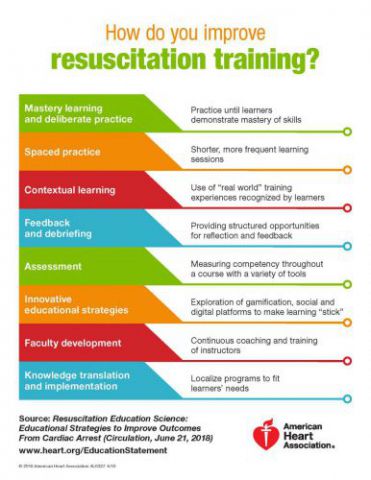
American Heart Association Scientific Statement addresses gaps in training that lead to flat survival rates for cardiac arrest victims
Statement Highlights:
- Addresses gaps in resuscitation training that lead to flat survival rates for cardiac arrest victims.
- Standardized online and in-person courses are falling short and not always implemented to optimize retention and mastery.
- Examines best practices in education and applies the learning in new resuscitation science, offering suggestions for improvement in training on eight key elements.
DALLAS, TX--More people will survive cardiac arrest if resuscitation course designers and instructors address shortcomings in educational offerings, new research shows. A new statement released today by the American Heart Association, the world’s leading voluntary health organization devoted to fighting cardiovascular disease, in its journal Circulation, indicates standardized online and in-person courses are falling short and not always implemented to optimize retention and mastery.
Resuscitation Education Science: Educational Strategies to Improve Outcomes From Cardiac Arrest examines best practices in education and applies the learning in new resuscitation science, offering suggestions for improvement in training on eight key elements:
- Mastery learning and deliberate practice (practice until learners demonstrate mastery of skills)
- Spaced practice (shorter, more frequent learning sessions)
- Contextual learning (use of “real world” training experiences recognized by learners)
- Feedback and debriefing (providing structured opportunities for reflection and feedback)
- Assessment (measuring competency throughout a course with a variety of tools)
- Innovative educational strategies (exploration of gamification, social and digital platforms to make learning “stick”)
- Faculty development (continuous coaching and training of instructors)
- Knowledge translation and implementation (localize programs to fit learners’ needs)
“Poor CPR quality is preventable. Educational activities are not consistently achieving their intended outcomes, as proven by significant decay in provider skills within months after training,” said Adam Cheng, M.D., associate professor at the University of Calgary, Alberta Children’s Hospital.
The Association is striving to double survival rates from cardiac arrest to 38 percent in-hospital and 15.8 percent for out-of-hospital as well as double bystander response to out-of-hospital cardiac arrest to 62 percent by the year 2020.
This statement marks the first time that resuscitation specialists have applied education best practices to resuscitation training, offering consolidated guidance to CPR instructors, educators and others who develop relevant content. It is applicable to all resuscitation training programs with students as diverse as medical professionals to bystanders.
“If we want to move the needle on cardiac arrest survival rates in the next two years, then we must focus on improving the quality of resuscitation education and knowledge translation efforts,” added Cheng, who is also an American Heart Association volunteer. “We identified an opportunity to build on the current scientific process in order to close the gap between desired and actual performance in resuscitation events – both for lay providers and healthcare professionals.”
For development of this statement, the Association assembled a steering committee whose members had expertise in resuscitation science and resuscitation education. This committee identified individuals with expertise in a key topic area for its working groups; various professions (nursing, medicine, paramedicine, respiratory therapy, psychology, research, education and hospital administration) and clinical specialties (critical care, pediatrics, neonatology, emergency medicine, anesthesia, internal medicine and cardiology) were represented in each working group.
The statement’s authors systematically examined the relevant published research, as well as published reviews relevant to the topic. The Association then held an educational summit focused on the eight key topic areas that are most likely to lead to improvements in educational and patient outcomes. Small-group sessions and roundtable discussions were integrated into the summit which allowed refinement of the recommendations coming from the literature review.
Since establishing its Guidelines for CPR & Emergency Cardiovascular Care in 1966, the Association has led evaluation and dissemination of the latest resuscitation science to help inform and modernize CPR. These guidelines have been used to train more than 22 million people annually in CPR, cardiovascular care and first aid around the world. This Statement builds on the Guidelines to help support improvement in CPR education and implementation – and ultimately save more lives.
The Association’s CPR and Emergency Cardiovascular Care courses include several of the eight key concepts, such as the flexibility to localize (contextualize) and standard performance based on observable behavior. In the coming months, the Association will examine its current courses to emphasize ways to further implement these concepts.
Read full statement in Circulation.
SOURCE: American Heart Association
